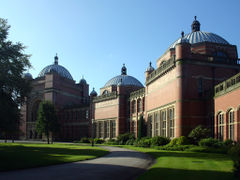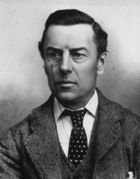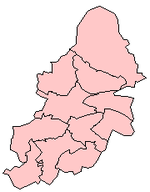Birmingham
| Birmingham | |||
|---|---|---|---|
| — City and Metropolitan borough — | |||
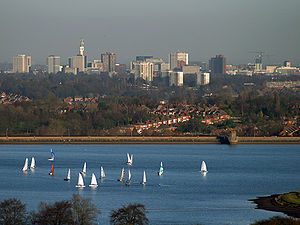 |
|||
|
|||
| Nickname(s): "Brum", "Brummagem", "Second City", "City of a thousand trades", "Workshop of the World" | |||
| Motto: Forward | |||
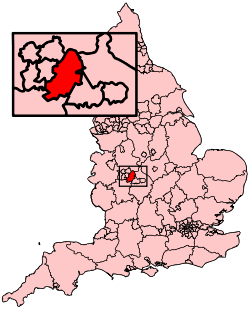 |
|||
| Coordinates: | |||
| Sovereign state | |||
| Constituent country | |||
| Region | West Midlands | ||
| Ceremonial county | West Midlands | ||
| Admin HQ | The Council House | ||
| Founded | 7th century | ||
| Municipal borough | 1838 | ||
| City | 1889 | ||
| Government | |||
| - Type | Metropolitan borough | ||
| - Body | Birmingham City Council | ||
| - Lord Mayor | Cllr. Len Gregory | ||
| - Deputy Lord Mayor | Cllr. Michael Wilkes | ||
| - Council Leader | Mike Whitby (C) | ||
| - Council Control | Conservative / Liberal Democrat Progressive Partnership | ||
| Area | |||
| - Total | 103.4 sq mi (267.77 km2) | ||
| Elevation | 459 ft (140 m) | ||
| Population (2008 est.) | |||
| - Total | 1,016,800 (Ranked 1st) | ||
| - Density | 9,684/sq mi (3,739/km2) | ||
| - Conurbation | 2,284,093 | ||
| - Ethnicity (2007 estimates[1]) |
66.7% White (62.1% White British) 21.0% South Asian 6.7% Black 3.2% Mixed Race 1.2% Chinese 1.2% Other |
||
| Time zone | Greenwich Mean Time (UTC+0) | ||
| - Summer (DST) | British Summer Time (UTC+1) | ||
| Postcode | B | ||
| Area code(s) | 0121 | ||
| ISO 3166 code | GB-BIR | ||
| ONS code | 00CN | ||
| OS grid reference | SP066868 | ||
| NUTS 3 | UKG31 | ||
| Website | birmingham.gov.uk | ||
Birmingham (pronounced /ˈbɜrmɪŋəm/ (![]() listen) BUR-ming-əm, locally [ˈbɜːmɪŋɡəm] BUR-ming-gəm) is a city and metropolitan borough in the West Midlands county of England. It is the most populous British city outside London with a population of 1,016,800 (2008 estimate),[2] and lies at the heart of the West Midlands conurbation, the United Kingdom's second most populous Urban Area with a population of 2,284,093 (2001 census).[3] Birmingham's metropolitan area, which includes surrounding towns to which it is closely tied through commuting, is the United Kingdom's second most populous with a population of 3,683,000.[4]
listen) BUR-ming-əm, locally [ˈbɜːmɪŋɡəm] BUR-ming-gəm) is a city and metropolitan borough in the West Midlands county of England. It is the most populous British city outside London with a population of 1,016,800 (2008 estimate),[2] and lies at the heart of the West Midlands conurbation, the United Kingdom's second most populous Urban Area with a population of 2,284,093 (2001 census).[3] Birmingham's metropolitan area, which includes surrounding towns to which it is closely tied through commuting, is the United Kingdom's second most populous with a population of 3,683,000.[4]
Birmingham was the powerhouse of the Industrial Revolution in England, a fact which led to it being known as "the workshop of the world" or the "city of a thousand trades".[5] Although Birmingham's industrial importance has declined, it has developed into a national commercial centre, being named as the second-best place in the United Kingdom to locate a business.[6] Birmingham is a national hub for conferences, retail and events along with an established high tech, research and development sector, supported by its three Universities. It is also the fourth-most visited city by foreign visitors in the UK,[7] has the second-largest city economy in the UK[8] and is often referred to as the Second City.
In 2010, Birmingham was ranked as the 55th-most livable city in the world, according to the Mercer Index of worldwide standards of living.[9] The Big City Plan is a large redevelopment plan currently underway in the city centre with the aim of making Birmingham one of the top 20 most liveable cities in the world within 20 years.[10] People from Birmingham are known as 'Brummies', a term derived from the city's nickname of 'Brum'. This may originate from the city's dialect name, Brummagem,[11] which may in turn have been derived from one of the city's earlier names, 'Bromwicham'.[12] There is a distinctive Brummie dialect and accent, both of which differ from the adjacent Black Country.
Contents |
History
Some of the earliest evidence of settlement in Birmingham are artefacts dating back 10,400 years discovered near Curzon Street in the city centre.[13]
In the early 7th century,[14] Birmingham was an Anglo-Saxon farming hamlet on the banks of the River Rea.[15] It is commonly believed that the name 'Birmingham' comes from "Beorma inga ham", meaning farmstead of the sons (or descendants) of Beorma.[15] Birmingham was first recorded in written documents by the Domesday Book of 1086 as a small village, worth only 20 shillings.[15] There were many variations on this name. Bermingeham is another version.

In 1166 the holder of the manor of Birmingham, Peter de Birmingham, was granted a royal charter to hold a market in his castle,[13][16] which in time became known as the Bull Ring, transforming Birmingham from a village to a market town. The de Birmingham family continued to be Lords of Birmingham until the 1530s when Edward de Birmingham was cheated out of its lordship by John Dudley.[17]
As early as the 16th century, Birmingham's access to supplies of iron ore and coal meant that metalworking industries became established.[18] By the time of the English Civil War in the 17th century, Birmingham had become an important manufacturing town with a reputation for producing small arms. Arms manufacture in Birmingham became a staple trade and was concentrated in the area known as the Gun Quarter. During the Industrial Revolution (from the mid-18th century onwards), Birmingham grew rapidly into a major industrial centre and the town prospered. Birmingham’s population grew from 15,000 in the late 17th century to 70,000 a century later.[19] During the 18th century, Birmingham was home to the Lunar Society, an important gathering of local thinkers and industrialists.[20]
Birmingham rose to national political prominence in the campaign for political reform in the early nineteenth century, with Thomas Attwood's Birmingham Political Union bringing the country to the brink of civil war and back during the Days of May that preceded the passing of the Great Reform Act in 1832.[21] The Union's meetings on Newhall Hill in 1831 and 1832 were the largest political assemblies Britain had ever seen.[22] Lord Durham, who drafted the act, wrote that "the country owed Reform to Birmingham, and its salvation from revolution".[23]
By the 1820s, an extensive canal system had been constructed, giving greater access to natural resources to fuel to industries. Railways arrived in Birmingham in 1837 with the arrival of the Grand Junction Railway, and a year later, the London and Birmingham Railway. During the Victorian era, the population of Birmingham grew rapidly to well over half a million[24] and Birmingham became the second largest population centre in England. Birmingham was granted city status in 1889 by Queen Victoria.[25] The city established its own university in 1900.[26]
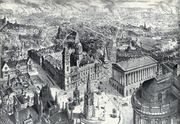
Birmingham suffered heavy bomb damage during World War II's "Birmingham Blitz", and the city was extensively redeveloped during the 1950s and 1960s.[27] This included the construction of large tower block estates, such as Castle Vale. The Bull Ring reconstructed and New Street station was redeveloped. In recent years, Birmingham has been transformed, with the construction of new squares like Centenary Square and Millennium Place. Old streets, buildings and canals have been restored, the pedestrian subways have been removed, and the Bull Ring shopping centre[28] has been completely redeveloped. These were the first steps in the ambitious plans of Birmingham City Council for the redevelopment of Birmingham, which has become known as the Big City Plan.[29]
In the decades following the Second World War, the ethnic makeup of Birmingham changed significantly, as it received waves of immigration from the Commonwealth of Nations and beyond.[30] The city's population peaked in 1951 at 1,113,000 residents.[24]
Governance
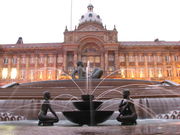
Birmingham City Council is the largest local authority in the UK and the largest council in Europe[31] with 120 councillors representing 40 wards.[32] Its headquarters are at the Council House in Victoria Square. No single party is in overall control and the council is run by a Conservative/Liberal Democrat coalition.
The city is also the seat of regional government for the West Midlands region of England as the home of the region's Government Office,[33] the regional development agency Advantage West Midlands,[34] and the West Midlands Regional Assembly.[35]
Birmingham's ten parliamentary constituencies are represented in the House of Commons by one Conservative, one Liberal Democrat and eight Labour MPs.[36] In the European Parliament the city forms part of the West Midlands European Parliament constituency, which elects six Members of the European Parliament.[34]
Birmingham was originally part of Warwickshire, but expanded in the late 19th and early 20th centuries, absorbing parts of Worcestershire to the south and Staffordshire to the north and west. The city absorbed Sutton Coldfield in 1974 and became a metropolitan borough in the new West Midlands county. Up until 1986, the West Midlands County Council was based in Birmingham City Centre.
Law enforcement in Birmingham is carried out by West Midlands Police, fire and rescue by West Midlands Fire Service and emergency medical care by West Midlands Ambulance Service.
Geography
Birmingham is located in the centre of the West Midlands region of England on the Birmingham Plateau – an area of relatively high ground, ranging around 500 to 1,000 feet (150–300 m) above sea level and crossed by Britain's main north-south watershed between the basins of the Rivers Severn and Trent. To the south and west of the city lie the Lickey Hills,[37] Clent Hills and Walton Hill, which reach 1,033 feet (315 m) and have extensive views over the city.
The City of Birmingham forms a conurbation with the largely residential borough of Solihull to the south east, and with the city of Wolverhampton and the industrial towns of the Black Country to the north west. Together these make up the West Midlands Urban Area, which covers 59,972 ha (600 km2; 232 sq mi) and has a population of 2,284,093 (2001 Census).[3]
Much of the area now occupied by the city was originally a northern reach of the ancient Forest of Arden, whose former presence can still be felt in the city's dense oak tree-cover and in the large number of districts such as Moseley, Saltley, Yardley, Stirchley and Hockley with names ending in "-ley": the Old English -lēah meaning "woodland clearing", (although in the case of Stirchley the name is actually derived from"Streetly" which is what is was called until around 200 years ago.[38]

Geology
Geologically, Birmingham is dominated by the Birmingham Fault which runs diagonally through the city from the Lickey Hills in the south west, passing through Edgbaston, the Bull Ring to Erdington and Sutton Coldfield in the north east.[39] To the south and east of the fault the ground is largely softer Mercia Mudstone Group (formerly known as Keuper Marl), interspersed with beds of Bunter pebbles and crossed by the valleys of the Rivers Tame, Rea and Cole along with their tributaries.[40] Much of this would have been laid down during the Permian and Triassic eras.[39] To the north and west of the fault, varying from 150 to 600 feet (45–180 m) higher than the surrounding area and underlying much of the city centre, lies a long ridge of harder Keuper Sandstone.[41][42]
Climate
The climate in Birmingham is classified as a temperate maritime climate, like much of the British Isles, with average maximum temperatures in summer (July) being around 20 °C (68 °F); and in winter (January) is around 4.5 °C (40.1 °F). Extreme weather is rare but the city has been known to experience tornados – the most recent being in July 2005 in the south of the city, damaging homes and businesses in the area.[43]
Occasional summer heatwaves, such as the one experienced in July 2006 have become more common in recent years, and winters have become milder since the 1990s with snow becoming much less frequent. Similar to most other large cities, Birmingham has a considerable 'urban heat island' effect.[44] During the coldest night recorded in Birmingham (14 January 1982), for example, the temperature fell to −20.8 °C (−5.4 °F) at Birmingham International Airport on the city's eastern edge, but just −12.9 °C (9 °F) at Edgbaston, near the city centre.[45] Relative to other large UK conurbations, Birmingham is a snowy city, due to its inland location and comparatively high elevation.[45] Snow showers often pass through the city via the Cheshire gap on North Westerly airstreams, but can also come off the North Sea from North Easterly airstreams.[45]
| Climate data for Birmingham | |||||||||||||
|---|---|---|---|---|---|---|---|---|---|---|---|---|---|
| Month | Jan | Feb | Mar | Apr | May | Jun | Jul | Aug | Sep | Oct | Nov | Dec | Year |
| Record high °C (°F) | 13 (55) |
16 (61) |
21 (70) |
24 (75) |
29 (84) |
31 (88) |
32 (90) |
33 (91) |
27 (81) |
25 (77) |
19 (66) |
14 (57) |
33 |
| Average high °C (°F) | 6.0 (42.8) |
6.2 (43.2) |
8.9 (48) |
11.9 (53.4) |
15.3 (59.5) |
19.3 (66.7) |
21.2 (70.2) |
20.8 (69.4) |
17.8 (64) |
13.8 (56.8) |
9.2 (48.6) |
7.1 (44.8) |
13.13 (55.63) |
| Average low °C (°F) | 0.3 (32.5) |
0.1 (32.2) |
1.5 (34.7) |
3.3 (37.9) |
6.0 (42.8) |
9.8 (49.6) |
11.5 (52.7) |
11.0 (51.8) |
8.8 (47.8) |
6.2 (43.2) |
2.9 (37.2) |
1.3 (34.3) |
5.23 (41.41) |
| Record low °C (°F) | -12 (10) |
-9 (16) |
-7 (19) |
-2 (28) |
-1 (30) |
3 (37) |
6 (43) |
6 (43) |
3 (37) |
-2 (28) |
-4 (25) |
-6 (21) |
-12 |
| Precipitation mm (inches) | 56 (2.2) |
48 (1.89) |
52 (2.05) |
48 (1.89) |
55 (2.17) |
57 (2.24) |
47 (1.85) |
67 (2.64) |
54 (2.13) |
53 (2.09) |
59 (2.32) |
66 (2.6) |
662 (26.06) |
| Source: United Nations World Meteorological Organization[46] | |||||||||||||
Nearby places
- Atherstone
- Bedworth
- Bromsgrove
- Cannock
- Coleshill
- Coventry
- Droitwich
- Dudley
- Halesowen
- Hinckley
- Kenilworth
- Kidderminster
- Lichfield
- Nuneaton
- Oldbury
- Redditch
- Royal Leamington Spa
- Rugby
- Solihull
- Stafford
- Stourbridge
- Stratford-upon-Avon
- Tamworth
- Telford
- Warwick
- Walsall
- West Bromwich
- Wolverhampton
- Worcester
Demography
| Religion | Percentage of population |
|---|---|
| Buddhist | 0.3% |
| Christian | 59% |
| Hindu | 2% |
| Jewish | 0.2% |
| Muslim | 14.3% |
| Sikh | 2.9% |
| No religion | 12.4% |
| No answer\ | 8.4% |
In 2007 the ONS estimated that 66.7% of the population was White (including 2.4% Irish & 2.2% Other White), 21% Asian, 6.7% Black, 1.2% Chinese, 3.2% of mixed race and 1.2% of other ethnic heritage.[47] 57% of primary and 52% of secondary pupils are from non-white British families.[48] 16.5% of the population was born outside the United Kingdom.
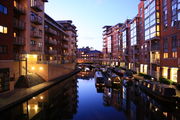
The population density is 9,451 inhabitants per square mile (3,649/km²) compared to the 976.9 inhabitants per square mile (377.2/km²) for England. Females represented 51.6% of the population whilst men represented 48.4%. More women were 70 or over.[49] 60.4% of the population was aged between 16 and 74, compared to 66.7% in England as a whole.[50]
60.3% of households were found to be owner occupied and 27.7% were rented from either the city council, housing association or other registered social landlord. The remaining 11.8% of households were rented privately or lived rent free.[50]
The Bimingham Larger Urban Zone, a Eurostat measure of the functional city-region approximated to local government districts, has a population of 2,357,100 in 2004.[51] In addition to Birmingham itself, the LUZ includes the Metropolitan Boroughs of Dudley, Sandwell, Solihull and Walsall, along with the districts of Lichfield, Tamworth, North Warwickshire and Bromsgrove.[52]
Places of interest
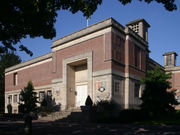
The Birmingham Museum & Art Gallery is the main art gallery and museum in Birmingham. It has renowned displays of artwork that include a leading collection of work by the Pre-Raphaelite Brotherhood and the world's largest collection of works by Edward Burne-Jones. The council also owns other museums in the city such as Aston Hall, Blakesley Hall, the Museum of the Jewellery Quarter, Soho House, and Sarehole Mill, a popular attraction for fans of J. R. R. Tolkien. Thinktank in the Eastside is one of the newest museums in the city, replacing the former Science & Industry Museum in Newhall Street. The Birmingham Back to Backs are the last surviving court of back-to-back houses in the city.[53]
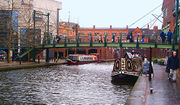
The Barber Institute of Fine Arts is both an art gallery and concert hall. It also has one of the world's most detailed and largest coin collections.[54] Cadbury World is a museum showing visitors the stages and steps of chocolate production and the history of chocolate and the company.
There are over 8,000 acres (3,237 ha) of parkland open spaces in Birmingham.[55] The largest of the parks is Sutton Park covering 2,400 acres (971 ha) making it the largest urban nature reserve in Europe.[56] Birmingham Botanical Gardens are a Victorian creation, with a conservatory and bandstand, close to the city centre. The Winterbourne Botanic Garden, maintained by the University of Birmingham, is also located close to the city centre. Woodgate Valley Country Park is in Bartley Green and Quinton.
The city centre consists of numerous public squares including Centenary Square, Chamberlain Square and Victoria Square. The historic Old Square is located on Corporation Street. Rotunda Square and St Martin's Square are two of the newest squares in Birmingham, being located within the Bullring Shopping Centre. Brindleyplace also consists of three squares and the National Sea Life Centre.
Places of worship
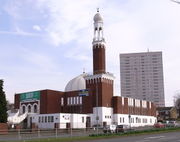
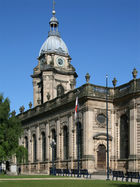
Birmingham's diverse population uses a wide variety of religious buildings in the city. St Philip's was upgraded from church to cathedral status in 1905. There are two other cathedrals, St Chad's, seat of the Roman Catholic Province of Birmingham, and the Greek Orthodox Dormition of the Mother of God and St Andrew. The Coptic Orthodox Diocese of the Midlands is also based at Birmingham (with a cathedral under construction). The original parish church of Birmingham, St Martin in the Bull Ring, is Grade II* listed. A short distance from Five Ways the Birmingam Oratory was completed in 1910 on the site of Cardinal Newman's original foundation.
The oldest surviving synagogue in Birmingham is the 1825 Greek Revival Severn Street Synagogue, now a Freemason's Lodge hall. It was replaced in 1856 by the Grade II* listed Singers Hill Synagogue. Birmingham Central Mosque, one of the largest in Europe, was constructed in the 1960s.[57] However, during the late 1990s Ghamkol Shariff Masjid was built in Small Heath and is claimed to be one of the largest in western Europe. Much more recently Darul Barakaat Mosque was built in the Bordesley Green area by the Ahmadiyya Muslim Community.[58] The Guru Nanak Nishkam Sewak Jatha Sikh Gurdwara was built on Soho Road in Handsworth in the late 1970s and the Buddhist Dhammatalaka Peace Pagoda near Edgbaston Reservoir in the 1990s.
Economy
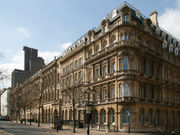
Although Birmingham grew to prominence as a manufacturing and engineering centre, its economy today is dominated by the service sector, which in 2003 accounted for 78% of the city's economic output and 97% of its economic growth.[59]
Two of Britain's largest banks were founded in Birmingham – Lloyds Bank (now Lloyds Banking Group) in 1765[60] and the Midland Bank (now HSBC Bank) in 1836[61] – as well as Ketley's Building Society, the world's first building society, in 1775.[62] As of 2007 the city employed 108,300 in banking, finance and insurance.[63] In 2009, Cushman & Wakefield stated that Birmingham was the second best place in the United Kingdom to locate a business, and the 14th best in Europe.[6]
Tourism is also an increasingly important part of the local economy. With major facilities such as the International Convention Centre and National Exhibition Centre the Birmingham area accounts for 42% of the UK conference and exhibition trade.[64] The city's sporting and cultural venues attract large numbers of visitors.
The city's three Universities, (Aston University, University of Birmingham and Birmingham City University) and two University colleges have over 65,000 students and employ around 15,000 staff, making a significant contribution to the city's economy as well as its research and innovation base.
With an annual turnover of £2.43bn, Birmingham city centre is the UK's third largest retail centre,[65] with the country's busiest shopping centre – the Bullring[66] – and the largest department store outside London – House of Fraser on Corporation Street.[67] The City also has one of only four Selfridges department stores, and the second largest branch of Debenhams in the country.[66] In 2004 the city was ranked as the third best place to shop in the United Kingdom, behind the West End of London and Glasgow, being described as a "world-class shopping centre".[68]
Despite the decline of manufacturing in the city several significant industrial plants remain, including Jaguar Cars in Castle Bromwich and Cadbury Trebor Bassett in Bournville.
Although the city has seen economic growth greater than the national average in the 21st century[69] the benefits have been uneven, with commuters from the surrounding area obtaining many of the more skilled jobs. The two parliamentary constituencies with the highest unemployment rates in the UK – Ladywood and Sparkbrook and Small Heath – are both in inner-city Birmingham.[70] Growth has also added to stresses on the city's transport. Many major roads and the central New Street railway station operate over capacity at peak times.
Transport
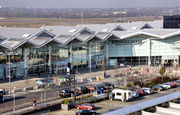
Partly because of its inland central location, Birmingham is a major transport hub on the motorway, rail, and canal networks.[71] The city is served by a number of major motorways and probably the best known motorway junction in the UK: Spaghetti Junction.[72]
The National Express UK headquarters are located on Birmingham's Eastside, alongside the newly developed Birmingham Coach Station, which forms the national hub of the company's coach network.
The nearest airport is Birmingham International Airport, located in the Borough of Solihull to the east of the city. As of 2009, the airport is the sixth busiest by passenger traffic in the United Kingdom.
Local public transport is by bus, local train and tram. The number 11A and 11C ('A' denotes anti-clockwise and 'C' denotes clockwise in relation to the journey's direction around the city) outer circle bus routes are the longest urban bus routes in Europe, being 26 miles (42 km) long[73] with 272 bus stops.[74] Bus routes are mainly operated by National Express West Midlands, which accounts for over 80% of all bus journeys in Birmingham, however, there are around 50 other, smaller registered bus companies.[75] The extensive bus network allows passengers to travel to and from various districts of the city, while there are longer bus routes which take passengers to areas further afield such as Wolverhampton, Dudley, Walsall, West Bromwich, Halesowen, Stourbridge and the Merry Hill Shopping Centre. The only towns in the West Midlands conurbation that currently lack a direct public transport link with Birmingham are Sedgley, Kingswinford, Wednesfield and Willenhall.
The city's main railway station, Birmingham New Street, is at the centre of the national railway network. Birmingham Snow Hill station, another major railway station in the city centre, is also a terminus for the Midland Metro which operates between the station and Wolverhampton, also serving the nearby towns of Bilston, Wednesbury and West Bromwich.[76] There are plans to extend the Midland Metro route further into Birmingham city centre.[77] Birmingham has a large rail-based park and ride network that feeds the city centre. see Birmingham Rail Stations
Birmingham is also notable for its expansive canal system, and the city is often noted for having more miles of canal than Venice. The canals fed the industry in the city during the Industrial Revolution. Canalside regeneration schemes such as Brindleyplace have turned the canals into tourist attractions.
Education
The city council is England's largest local education authority, directly or indirectly responsible for 25 nursery schools, 328 primary schools, 77 secondary schools[78] and 29 special schools.[79] It also runs the library service, with 4 million visitors annually,[80] and provides around 3,500 adult education courses throughout the year.[81] The main library is Central Library and there are 41 local libraries in Birmingham, plus a regular mobile library service.[82]
Most of Birmingham's state schools are community schools run directly by Birmingham City Council in its role as local education authority (LEA). However, there are a large number of voluntary aided schools within the state system. King Edward's School is perhaps the most prestigious independent school in the city. The seven schools of The King Edward VI Foundation are known nationally for setting very high academic standards and all the schools consistently achieve top positions in national league tables.[83]

Birmingham is home to three universities: the University of Birmingham, Aston University, Birmingham City University; and two university colleges: Newman University College[84] and University College Birmingham.[85] The Birmingham Conservatoire and Birmingham School of Acting, both now part of Birmingham City University, offer higher education in specific arts subjects. The range of Universities and colleges means that there are over 65,000 higher education students in Birmingham, making it the UK's second largest student city to London. The Joseph Chamberlain Memorial Clock Tower is a campanile located in Chancellor's court at the University of Birmingham. It is the tallest free-standing clock tower in the world.
Birmingham Metropolitan College is one of the largest further education colleges in the country,[86] formed through a series of mergers between smaller colleges. Joseph Chamberlain College is the only sixth form college in Birmingham and Solihull to have been awarded both Beacon Status and an overall OFSTED grade 1 (Outstanding).[87]
Since the 1970s, most secondary schools in Birmingham have been 11-16/18 comprehensive schools, while post GCSE students have the choice of continuing their education in either a school's sixth form or at a further education college. Birmingham has always operated a primary school system of 5–7 infant and 7–11 junior schools.
Sport
Birmingham has played an important part in the history of sport. The Football League – one of the world's first league football competition – was founded by Birmingham resident and Aston Villa director William McGregor, who wrote to fellow club directors in 1888 proposing "that ten or twelve of the most prominent clubs in England combine to arrange home-and-away fixtures each season".[88] The modern game of tennis was developed between 1859 and 1865 by Harry Gem and his friend Augurio Perera at Perera's house in Edgbaston,[89] with the Edgbaston Archery and Lawn Tennis Society remaining the oldest tennis club in the world.[90] The Birmingham and District Cricket League is the oldest cricket league in the world,[91] and Birmingham was the host for the first ever Cricket World Cup, a Women's Cricket World Cup in 1973.[92] Birmingham was the first city to be named National City of Sport by the Sports Council.[93]. Birmingham bid unsuccessfully to host the 1992 Summer Olympics.

Today the city is home of two of the country's oldest professional football teams: Aston Villa, who were founded in 1874 and play at Villa Park; and Birmingham City, who were founded in 1875 and play at St Andrew's. Rivalry between the clubs is fierce and the fixture between the two is called the Second City derby.[94] Aston Villa have won the fixture 50 times as opposed to Birmingham City's 38 wins. Both teams have won trophies, with Villa having been League champions on seven occasions and European Champions in 1982.
Six times County Championship winners Warwickshire County Cricket Club play at Edgbaston Cricket Ground, which also hosts test cricket and one day internationals. The venue was the scene of the highest ever score by a batsman in first-class cricket, when Brian Lara scored 501 not out for Warwickshire in 1994.[95]
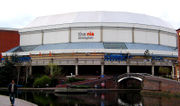
International track and field meetings take place at Alexander Stadium, the home of Birchfield Harriers which has many international athletes amongst its members. The GMAC Gymnastics and Martial Arts Centre, alongside Alexander Stadium, opened in 2008 and houses an international standard gymnastics hall and three martial arts dojos, including the headquarters of the Aikido Fellowship of Great Britain. The National Indoor Arena (NIA), opened in 1991,[96] is a major indoor athletics venue, hosting the 2007 European Athletics Indoor Championships and 2003 IAAF World Indoor Championships as well as many WWE wrestling events.
WTA Tour tennis is still played at Edgbaston's Priory Club.[97] Birmingham also has a professional Rugby Union side, Moseley RFC, who play at Billesley Common, as well as professional boxing, hockey, skateboarding, stock-car racing, greyhound racing and speedway in the city.
Food & drink
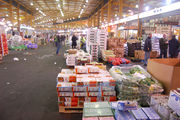
Birmingham's development as a commercial town was originally based around its market for agricultural produce, established by royal charter in 1166. Despite the industrialisation of subsequent centuries this role has been retained, and the Birmingham Wholesale Markets remain the largest combined wholesale food markets in the country,[98] selling meat, fish, fruit, vegetables and flowers and supplying fresh produce to restaurateurs and independent retailers as far as 100 miles away.[99]
Birmingham is the only English city outside London to have three Michelin starred restaurants: Simpson's in Edgbaston, Turners in Harborne and Purnell's in the city centre.[100]
Birmingham based breweries included Ansells, Davenports and Mitchells & Butlers.[101] Aston Manor Brewery is currently the only brewery of any significant size. Many fine Victorian pubs and bars can still be found across the city. The oldest inn in Birmingham is the Old Crown in Deritend (circa 1450). The city has a plethora of nightclubs and bars, notably along Broad Street.[102]
The Wing Yip food empire first began in the city and now has its headquarters in the Nechells.[103] The Balti, a type of curry, was invented in the city, which has received much acclaim for the 'Balti Belt' or 'Balti Triangle'.[104] Famous food brands that originated in Birmingham include Typhoo tea, Bird's Custard, Cadbury's chocolate and HP Sauce.
Culture and arts
Birmingham is home to a number of theatres, music venues and galleries. The city made the shortlist for the first city to be designated UK City of Culture, but in July 2010 it was announced that Derry had been selected.[105]
Arts
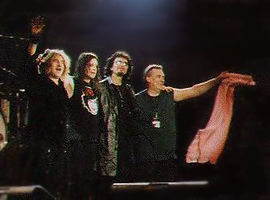
Birmingham has had a vibrant and varied musical history over the last century. Birmingham bands have made a major contribution to the musical culture of the United Kingdom, with many contemporary bands citing Birmingham bands as a major influence. In the 1960s, the "Brum Beat" era featured blues and early progressive rock bands, such as The Moody Blues. The city is often described as the birthplace of heavy metal music,[106] with Judas Priest, Black Sabbath, Magnum and two members of Led Zeppelin being local. Then later on during the 80s bands such as Napalm Death, joined the Birmingham heavy metal scene.
In the 1970s, members of The Move and The Idle Race formed the Electric Light Orchestra and Wizzard. The 1970s also saw the rise of reggae and ska in the city with such bands as Steel Pulse, UB40, Musical Youth and The Beat, expounding racial unity with politically leftist lyrics and multiracial lineups, mirroring social currents in Birmingham at that time. Seminal 1980s pop band Duran Duran are also from Birmingham.
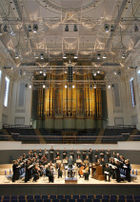
Jazz has a following in the city, and the annual Birmingham International Jazz Festival is the largest of its kind in the UK.[107] Venues for the festival are also located out of Birmingham in Solihull. It was first held in 1984.[108]
The internationally-renowned City of Birmingham Symphony Orchestra's home venue is Symphony Hall. There is a City Organist; since 1834 only seven men have held this position. The current holder, Thomas Trotter, has been in post since 1983.[109] Weekly recitals have been given since the organ in Birmingham Town Hall was opened[110] but are now held in St. Philip's Cathedral, until the Town Hall organ opens in October 2007, following restoration. The Birmingham Royal Ballet[111] resides in the city as does the world's oldest vocational dance school, Elmhurst School for Dance.[112]
The Birmingham Triennial Music Festivals took place from 1784 to 1912. Music was specially composed, conducted or performed by Mendelssohn, Gounod, Sullivan, Dvořák, Bantock and Edward Elgar, who wrote four of his most famous choral pieces for Birmingham. Elgar's The Dream of Gerontius had its début performance there in 1900. Composers born in the city include Albert William Ketèlbey and Andrew Glover.
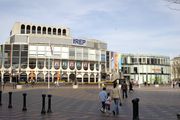
Birmingham's other city-centre music venues include The National Indoor Arena, which was opened in 1991, 02 Academy on Bristol Street, which opened in September 2009 replacing the 02 Academy in Dale End, The CBSO Centre, opened in 1997, Barfly in Digbeth and the Adrian Boult Hall, which was built along with Paradise Forum and Birmingham Central Library, at Birmingham Conservatoire.
Among the many theatres in Birmingham, the largest are the Alexandra ("the Alex"), The Rep, the Hippodrome and the Old Rep. The Crescent Theatre and Old Joint Stock Theatre are other city centre theatres. Outside of the city centre are the Drum Arts Centre (on the site of the former Aston Hippodrome) and mac.[113] The Fierce! festival collaborates with The Rep to present an annual series of performances from local and national companies.
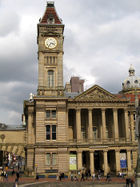
Literary figures associated with Birmingham include Samuel Johnson who stayed in Birmingham for a short period and was born in nearby Lichfield. The Birmingham Central Library holds some two thousand volumes of his work. Arthur Conan Doyle worked in the Aston area of Birmingham whilst poet Louis MacNeice lived in Birmingham for six years. American author Washington Irving produced several of his most famous literary works whilst staying in Birmingham such as Bracebridge Hall and The Humorists, A Medley which are based on Aston Hall. Other authors who were born in or have resided in Birmingham include David Lodge, Jonathan Coe and J. R. R. Tolkien, who is said to have been inspired by areas and buildings in the city. Influential poets associated with Birmingham include Roi Kwabena, who was the city's sixth poet laureate,[114] and Benjamin Zephaniah, who was born in the city.
Birmingham is the home of the UK's longest-established local science fiction group, launched in 1971 (although there were earlier incarnations in the 1940s and 1960s) and which organises the annual sf event Novacon.
Birmingham Museum & Art Gallery has one of the largest collections of Pre-Raphaelite art in the world. Edward Burne-Jones was born in Birmingham, spent his first twenty years in the city, later becoming president of the Royal Birmingham Society of Artists. The Barber Institute of Fine Arts was declared 'Gallery of the Year' by the 2004 Good Britain Guide.[115] The Ikon Gallery hosts displays of contemporary art, as does Eastside Projects. Notable local artists include David Cox, David Bomberg, Pogus Caesar, Keith Piper and Donald Rodney. OOM Gallery a photographic archive has collaborated with organisations such as Fazeley Studios Three White Walls and Kinetic AIU.
Birmingham's role as a manufacturing and printing centre has supported strong local traditions of graphic design and product design. Iconic works by Birmingham designers include the Baskerville font,[116] Ruskin Pottery,[117] the Acme Thunderer whistle,[118] the Art Deco branding of the Odeon Cinemas[119] and the Mini.[120]
Festivals and shows
Birmingham is home to many national, religious and spiritual festivals including a St. George's Day party. The Birmingham Tattoo is a long-standing military show held annually at the National Indoor Arena. The Caribbean-style Birmingham International Carnival takes place in odd numbered years. Birmingham Pride takes place in the gay village and attracts up to 100,000 visitors each year. From 1997, the city hosted an annual arts festival ArtsFest, the largest free arts festival in the UK. In December 2006, the City Council announced that it would no longer hold Artsfest.[121] The city's largest single-day event is its St. Patrick's Day parade (Europe's second largest, after the one in Dublin).[122] Other multicultural events include the Bangla Mela and the Vaisakhi Mela. The Birmingham Heritage Festival is a Mardi Gras style event in August. Caribbean and African culture are celebrated with parades and street performances by buskers.
Other festivals in the city include Moseley Folk Festival (since 2006), which takes place in Moseley private park and mixes new with established folk acts, the Birmingham International Jazz Festival, Birmingham Comedy Festival (since 2001), which has been headlined by such acts as Peter Kay, The Fast Show, Jimmy Carr, Lee Evans and Lenny Henry and Off The Cuff Festival established in 2009.The festivals, shows and other activities make Birmingham are part of Birmingham's 2026 vision, publicised by Be Birmingham (a Local Strategic Partnership to Birmingham) which aims to improve the range of public festivals and activities in the city. The Birmingham bid to be named City of Culture[123] in 2013 is backed by celebrity advocates among them Kris Akabusi, Denise Lewis and James Phelps & Oliver Phelps (The Weasley Twins from Harry Potter). The biennial International Dance Festival Birmingham started in 2008, organised by DanceXchange and involving indoor and outdoor venues across the city.
Media
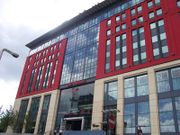
Birmingham has several major local newspapers – the daily Birmingham Mail and Birmingham Post and the weekly Sunday Mercury, all owned by the Trinity Mirror who also own What's On magazine, a fortnightly listings title which has been running for 30 years. Forward (formerly Birmingham Voice) is a freesheet produced by Birmingham City Council, which is distributed to homes in the city. Birmingham is also the hub for various national ethnic media and the base for two regional Metro editions (east and west Midlands). Birmingham has a long cinematic history.
The Electric Cinema on Station Street is the oldest working cinema in the UK,[124] and Oscar Deutsch opened his first Odeon cinema in Perry Barr during the 1920s. Birmingham-born architect Harry Weedon collaborated with Oscar Deutsch to design over 300 cinemas across the country, most in the distinctive Art Deco style.[125] Star City is said to be Europe's largest leisure and cinema complexes. An IMAX cinema is located at Millennium Point in the Eastside.[126] Birmingham has also been the location for films including Felicia's Journey of 1999, which used locations in Birmingham that were used in Take Me High of 1973 to contrast the changes in the city.[127]
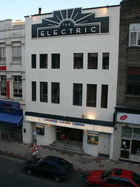
As well as being the location for television dramas, Birmingham is also a national hub for television broadcasting. The BBC has two facilities in the city. The Mailbox, in the city centre, is the location for the national headquarters of BBC English Regions,[128] the headquarters of BBC West Midlands and the BBC Birmingham network production centre, which were previously located at the Pebble Mill Studios in Edgbaston. The BBC Drama Village, based in Selly Oak, is a production facility specialising in television drama and in the newest UK soap opera and the only television soap opera in the West Midlands region, Doctors what is the only daytime soap in the UK.[129] It was announced in October 2007 that BBC Birmingham was to lose 43 out of 2,500 jobs nationwide.
Central/ATV studios in Birmingham were the location for the recording of many programmes for ITV including Tiswas and Crossroads until the complex was closed.[130] When Central TV moved to its current Gas Street studios, it was also the main hub for CITV until CITV was moved to Manchester in 2004. All of ITV Central's output from Birmingham now consists of the West and East editions of the regional news programme Central Tonight.
The city is served by numerous national and regional radio stations, as well as local radio stations. These include 96.4 BRMB, Galaxy, Heart FM, Kerrang! 105.2, New Style Radio 98.7FM, Smooth Radio 105.7FM and BBC WM.[131] The Archers, the world's longest running radio soap, is recorded in Birmingham for BBC Radio 4.[132]
Leisure
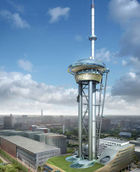
Two major developments have regenerated two parts of the city in recent years. Brindleyplace is a major canalside development with restaurants and office buildings along with the National Sea Life Centre. The other development was the Bullring Shopping Centre, which replaced a previous shopping centre. The Mailbox, a canalside development, features designer stores as well as offices and apartments. The Cube, designed by MAKE Architects is a 17 storey mixed-use development which is under construction as part of the Mailbox masterplan. The National Indoor Arena is one of the busiest large scale sporting and entertainment venues in Europe. Outside of the city centre is Star City entertainment complex on the former site of Nechells Power Station.[133]
The nightlife in Birmingham is concentrated mainly along Broad Street and into Brindleyplace. However, in recent years, stylish clubs and bars have started to establish themselves outside the Broad Street area. The Medicine Bar in the Custard Factory, The Sanctuary, Rainbow Pub and Air are large clubs and bars in Digbeth. Near Digbeth, there are bars and club nights in areas such as the Arcadian and Hurst Street Gay Village by the Chinese Quarter. Summer Row, The Mailbox, and St Philips/Colmore Row – where once a month there is a party night held for Polish residents in Birmingham – and Jewellery Quarter also feature clubs. There are number of late night pubs in the Irish Quarter.[134]
Planning permission has been granted to build a fifty-metre Olympic sized swimming pool in Ladywood next to the NIA. The "Birmingham Aquatics and Leisure Centre" or "BALC" will cost £58 million and was originally planned to be completed in time for the 2012 Olympic Games in London so that the Chinese Swimming Team could use it for practice sessions, although due to budget constraints it will not be built in time.[135] Building work is unlikely to start any time soon despite planning permission being granted. The pool has been a source of heated debate with local residents due to its proximity to other large sporting venues.[136]
Architecture
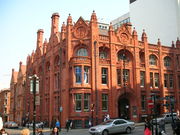
Birmingham is chiefly a product of the 18th, 19th, and 20th centuries; its growth began during the Industrial Revolution. Consequently, relatively few buildings survive from its earlier history, and those that do are protected. There are 1,946 listed buildings in Birmingham and thirteen scheduled ancient monuments.[137] Birmingham City Council also operate a locally listing scheme for buildings that do not fully meet the criteria for statutorily listed status.
Traces of medieval Birmingham can be seen in the oldest churches, notably the original parish church, St Martin in the Bull Ring. A few other buildings from the medieval and Tudor periods survive, among them the Lad in the Lane[138] and The Old Crown, the 15th century Saracen's Head public house and Old Grammar School in Kings Norton[139] and Blakesley Hall.
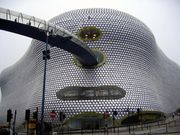
A number of Georgian buildings survive, including St Philip's Cathedral, Soho House, Perrott's Folly, the Town Hall and much of St Paul's Square. The Victorian era saw extensive building across the city. Major civic buildings such as the Victoria Law Courts (in characteristic red brick and terracotta), the Council House and the Museum & Art Gallery were constructed.[140] St Chad's Cathedral was the first Roman Catholic cathedral to be built in the UK since the Reformation.[141] Across the city, the need to house the industrial workers gave rise to miles of redbrick streets and terraces, many of back-to-back houses, some of which were later to become inner-city slums.[142]
Postwar redevelopment and anti-Victorianism resulted in the loss of dozens Victorian buildings like Birmingham New Street Station, and the old Central Library.[143] In inner-city areas too, much Victorian housing was redeveloped. Existing communities were relocated to tower block estates like Castle Vale.[144]
Birmingham City Council now has an extensive tower block demolition and renovation programme. There has been a lot of construction in the city centre in recent years, including the award-winning[145] Future Systems' Selfridges building in the Bullring Shopping Centre, the Brindleyplace regeneration project and the Millennium Point science and technology centre. Funding for many of these projects has come from the European Union; the Town Hall for example received £3 million in funding from the European Regional Development Fund.[146]
Highrise development has slowed since the 1970s and mainly in recent years due to enforcements imposed by the Civil Aviation Authority on the heights of buildings as they could affect aircraft from the International Airport (e.g. Beetham Tower).[147]
Environment
Birmingham has many corridors of wildlife that lie in both informal settings such as the Project Kingfisher and Woodgate Valley Country Park and in a selection of parks such as Handsworth Park and Small Heath Park. The City's horticultural training facility at King's Heath Park is paired up with Pershore College. More traditional environmental concerns are constantly raised by volunteer pressure group Birmingham Friends of the Earth. That group advocate sustainable travel such as local rail revival, walking and cycling, reduction in energy demand and waste generally, and the development of environmental technologies in the city. in the South of Birmingham is Cofton Park and the Lickey Hills and the Waseley hills which overlook the city centre and gets some great panaromic views of the city at night.
Crime and policing
West Midlands Police serves Birmingham and the West Midlands county. The headquarters are located at Lloyd House in the city centre of Birmingham. Birmingham has been the location for many high profile incidents such as the 31 January 2007 Birmingham raid, New Year Murders, the 2005 Birmingham race riots and in 1974, the Birmingham pub bombings.
Crime figures for 2008/2009 (shown below) demonstrated that Birmingham was above the English average in most, but not all, fields. Of England's 'core cities' (Birmingham, Bristol, Leeds, Liverpool, Manchester, Newcastle, Nottingham, and Sheffield), Birmingham has the lowest crime rate.[148]
In an attempt to reduce crime in the city, a Crime and Disorder Partnership has been established in the city, the largest of its kind in the country.[149] The partnerships work in developing five neighbourhood based community safety projects in Birmingham was recognised when it was awarded first prize at the European Community Safety Awards in December 2004.[149] Crime rates are particularly high in areas such as Aston, Handsworth, Small Heath and Bordesley Green.[149]
| Crime | Birmingham average (per 1,000 of the population) |
English average (per 1,000 of the population) |
|---|---|---|
| Total recorded offences | 94.92 | 86 |
| Violence against a person | 21.55 | 16 |
| Sexual offences | 1.24 | 1 |
| Robbery offences | 3.88 | 2 |
| Burglary | 12.19 | 11 |
| Offences against vehicles | 14.34 | 11 |
| Other theft offences | 15.24 | 20 |
| Criminal damage | 15.9 | 17 |
| Drug offences | 5.22 | 4 |
Notable residents
Birmingham has a number of notable residents from various walks of life. Joseph Chamberlain, who was once mayor of Birmingham and later became an MP, and his son Neville Chamberlain, who was lord mayor Birmingham and later the British Prime Minister, are two of the most well-known political figures who have lived in Birmingham. Politician Enoch Powell was also born in Birmingham attending King Edward's School. Author J. R. R. Tolkien was brought up in Birmingham with many locations in the city such as Moseley bog, Sarehole Mill and Perrott's Folly supposedly being the inspiration for various scenes in The Lord of the Rings.
Writer W. H. Auden grew up in the Harborne area of the city. The American author Washington Irving lived in Birmingham during the 1820s and wrote both Rip Van Winkle and The Legend of Sleepy Hollow whilst living in the city. Entertainers who were born or who have lived in Birmingham include comedians Sid Field, Tony Hancock, and Jasper Carrott and the actors Trevor Eve, Adrian Lester, Julie Walters and Martin Shaw.
Birmingham has also produced a number of popular bands and musicians including Led Zeppelin, Electric Light Orchestra, UB40, Duran Duran, Steel Pulse, Ocean Colour Scene, Moody Blues, The Move, Judas Priest, Black Sabbath, Napalm Death,The Spencer Davis Group, Musical Youth, The Streets and The Twang. Musicians Jeff Lynne, Ozzy Osbourne, Tony Iommi, John Lodge, Roy Wood, Joan Armatrading, Toyah Willcox, Denny Laine, Steve Winwood and Fyfe Dangerfield all grew up in the city. Other famous residents include the engineer James Watt; award winning political playwright David Edgar; and Booker Prize winning novelist David Lodge.
The 'Walk of Stars', was unveiled on Broad Street in July 2007 to honour the famous residents of Birmingham.[152]
See also: Blue Plaques erected by the Birmingham Civic Society.
Science and invention
Birmingham has been the location for some of the most important inventions and scientific breakthroughs. Local inventions and notable firsts include: gas lighting, custard powder, Brylcreem, the magnetron, the first ever use of radiography in an operation,[153] Lewis Paul and John Wyatt's first cotton Roller Spinning machine and the UK's first ever hole-in-the-heart operation, at Birmingham Children's Hospital.[154]
Among the city's notable scientists and inventors are Matthew Boulton, proprietor of the Soho engineering works, Sir Francis Galton, originator of eugenics and important techniques in statistics, Joseph Priestley, chemist and radical and James Watt, engineer and inventor who is associated with the steam engine. Many of these scientists were members of the Lunar Society, which was based in the city.[155]
Twin cities
Birmingham has six twin cities, which Birmingham City Council refers to as "international partner cities".[156] They are:
There are also Treaties of Friendship between Birmingham and Guangzhou in China,[156][161] and between Birmingham and Mirpur in Azad Kashmir from where about 90,000 Birmingham citizens originate.[162]
Birmingham, Alabama, USA, is named after the city and shares an industrial kinship.[163]
See also
- Constituent areas of Birmingham
- List of tallest buildings and structures in Birmingham
- Military history of Birmingham
- Redevelopment of Birmingham
References
Bibliography
- An History of Birmingham (1783) by William Hutton at Project Gutenberg
- Gordon E. Cherry (1994). Birmingham A Study in Geography, History and Planning. ISBN 0-471-94900-0.
- Canon Doctor Terry Slater (1981). A History of Warwickshire. ISBN 0-85033-416-0.
- Johnathan Berg (1994). Positively Birmingham. ISBN 0-9523179-0-7.
- A. J. Gerard; Canon Doctor Terry Slater (1996). Managing a Conurbation: Birmingham and its Region. ISBN 1-85858-083-8.
Notes
- ↑ "Resident Population Estimates by Ethnic Group (Percentages)". Neighbourhood Statistics. June 2006. http://www.neighbourhood.statistics.gov.uk/dissemination/LeadTableView.do?a=3&b=276800&c=birmingham&d=13&e=13&g=373272&i=1001x1003x1004&m=0&r=1&s=1256075609225&enc=1&dsFamilyId=1812. Retrieved 23 October 2008.
- ↑ "Local Authority Profile – Birmingham". Nomis – Official Labour Market Statistics. Office for National Statistics. 2009. https://www.nomisweb.co.uk/reports/lmp/la/2038431965/report.aspx. Retrieved 9 January 2010.
- ↑ 3.0 3.1 "Usual resident population: Census 2001, Key Statistics for urban areas". Office for National Statistics. http://www.statistics.gov.uk/statbase/ssdataset.asp?vlnk=8271&More=Y. Retrieved 9 June 2007.
- ↑ "British urban pattern: population data" (PDF). ESPON project 1.4.3 Study on Urban Functions. European Union – European Spatial Planning Observation Network. March 2007. http://www.espon.eu/mmp/online/website/content/projects/261/420/file_2420/fr-1.4.3_April2007-final. Retrieved 14 March 2009.
- ↑ "Decline of the city of a thousand trades". Birmingham Mail. 17 April 2006. http://icbirmingham.icnetwork.co.uk/mail/news/columnists/goldberg/tm_objectid=16955982&method=full&siteid=50002&headline=decline-of-the-city-of-a-thousand-trades-name_page.html. Retrieved 2 August 2006.
- ↑ 6.0 6.1 Anna Blackaby (6 October 2009). "Birmingham, biggest mover in European league table, second to London for UK business". http://www.birminghampost.net/news/newsaggregator/2009/10/06/birmingham-biggest-mover-in-european-league-table-second-to-london-for-uk-business-65233-24859371/.
- ↑ "National Statistics Online – International Visits". ONS. http://www.statistics.gov.uk/cci/nugget.asp?id=178. Retrieved 19 July 2009.
- ↑ UKmediacentre.pwc.com
- ↑ "Quality of Living worldwide city rankings 2010 – Mercer survey". Mercer. 26 May 2010. http://www.mercer.com/qualityoflivingpr#Europe. Retrieved 27 May 2010.
- ↑ "Big City Plan Website". Birmingham City Council. http://bigcityplan.birmingham.gov.uk/. Retrieved 27 January 2010.
- ↑ "Brummagem". Worldwidewords.com. 13 December 2003. http://www.worldwidewords.org/weirdwords/ww-bru2.htm. Retrieved 7 June 2008.
- ↑ William Hutton (1783). An History of Birmingham.
- ↑ 13.0 13.1 "Evidence of Stone Age man found in Digbeth". Birmingham Post. http://www.birminghampost.net/news/west-midlands-news/2009/07/24/evidence-of-stone-age-man-found-in-digbeth-65233-24226815/. Retrieved 28 July 2009.
- ↑ Bassett, Anglo-Saxon Birmingham, 2000
- ↑ 15.0 15.1 15.2 "Birmingham or Brummagem?". Birmingham City Council. http://www.birmingham.gov.uk/cs/Satellite?c=Page&childpagename=SystemAdmin%2FPageLayout&cid=1223092625903&packedargs=subtype%3DPressNewsStandardTemplate%26website%3D1&pagename=BCC%2FCommon%2FWrapper%2FWrapper&rendermode=live. Retrieved 13 January 2010.
- ↑ "Historic Birmingham". Birminghamuk.com. http://www.birminghamuk.com/historicbirmingham.htm. Retrieved 30 May 2009.
- ↑ "IONA – Birmingham". Project-iona.co.uk. Archived from the original on October 20, 2007. http://web.archive.org/web/20071020214707/http://www.project-iona.co.uk/landscape/cityscape_past_and_present/birmingham. Retrieved 30 May 2009.
- ↑ Hugh Miller (1851). First Impressions of England and Its People. Gould and Lincoln.
- ↑ "Birmingham (England, United Kingdom)". Encyclopædia Britannica.
- ↑ "History of Birmingham 2". BirminghamUK. http://www.birminghamuk.com/historic2.htm. Retrieved 7 June 2008.
- ↑ Hilton, Boyd (2006). A Mad, Bad, and Dangerous People?: England, 1783–1846. Oxford University Press. pp. 426–427. ISBN 0-19-822830-9. http://books.google.com/?id=D37VByMZSaUC. Retrieved 7 January 2009.
- ↑ Flick, Carlos T. (August 1971). "Thomas Attwood, Francis Place, and the Agitation for British Parliamentary Reform". The Huntington Library Quarterly (University of California Press) 34 (4): 359. http://www.jstor.org/stable/3816950. Retrieved 10 January 2009.
- ↑ Briggs, Asa (1948). "Thomas Attwood and the Economic Background of the Birmingham Political Union". Cambridge Historical Journal (Cambridge University Press) 9 (2): 190. http://www.jstor.org/stable/3020620. Retrieved 6 January 2009.
- ↑ 24.0 24.1 "Historic Population Of Birmingham". Birmingham City Council. http://www.birmingham.gov.uk/cs/Satellite?c=Page&childpagename=Lib-Central-Archives-and-Heritage%2FPageLayout&cid=1223092760414&pagename=BCC%2FCommon%2FWrapper%2FWrapper. Retrieved 13 January 2010.
- ↑ "History of Mayoralty". Birmingham.gov.uk. Archived from the original on June 9, 2008. http://web.archive.org/web/20080609052542/http://www.birmingham.gov.uk/mayors. Retrieved 7 June 2008.
- ↑ "Inside the university". University of Birmingham. Archived from the original on 2 January 2008. http://web.archive.org/web/20080102065752/http://www.bham.ac.uk/about/. Retrieved 7 June 2008.
- ↑ "1960s Architecture in Birmingham" (PDF). Birmingham City Council Planning Department. http://www.birmingham.gov.uk/cs/Satellite?blobcol=urldata&blobheader=application%2Fpdf&blobheadername1=Content-Disposition&blobheadervalue1=attachment%3B+filename%3D6415485.pdf&blobkey=id&blobtable=MungoBlobs&blobwhere=1223418010271&ssbinary=true. Retrieved 13 January 2010.
- ↑ "Major Developments". Birmingham City Council. http://www.birmingham.gov.uk/majordevelopments. Retrieved 7 June 2008.
- ↑ Bayley, Stephen (30 June 2008). "Article reviewing the Architectural regeneration of Birmingham City Centre". London: Guardian. http://www.guardian.co.uk/artanddesign/2008/jun/29/architecture.regeneration. Retrieved 25 January 2010.
- ↑ "Birmingham's Post War Black Immigrants". Birmingham City Council. Archived from the original on 2008-06-09. http://web.archive.org/web/20080609021432/http://www.birmingham.gov.uk/GenerateContent?CONTENT_ITEM_ID=2392&CONTENT_ITEM_TYPE=0&MENU_ID=10596. Retrieved 22 July 2009.
- ↑ "Corporate Marketing and Promotions Team: Sponsorship". Birmingham City Council. http://www.birmingham.gov.uk/cs/Satellite/sponsorship?packedargs=website%3D1&rendermode=live. Retrieved 12 September 2009.
- ↑ "Wards". Birmingham City Council. http://www.birmingham.gov.uk/wards. Retrieved 13 January 2010.
- ↑ "Contact Us". Government Office for the West Midlands. http://www.gos.gov.uk/gowm/contactUs/. Retrieved 3 February 2009.
- ↑ 34.0 34.1 "Contact us". Advantage West Midlands. http://www.advantagewm.co.uk/about-awm/contact-us/default.aspx. Retrieved 3 February 2009.
- ↑ "Contact Us". West Midlands Regional Assembly. http://www.wmra.gov.uk/contact_us/Contact_Us.aspx. Retrieved 3 February 2009.
- ↑ "Members of Parliament". Birmingham City Council. http://www.birmingham.gov.uk/mps. Retrieved 13 January 2010.
- ↑ "Lickey Hills Country Park". Birmingham City Council. http://www.birmingham.gov.uk/lickey. Retrieved 13 January 2010.
- ↑ Hooke, Della (2005). "Mercia: Landscape and Environment". In Brown, Michelle P.; Farr, Carol Ann. Mercia: an Anglo-Saxon kingdom in Europe. Continuum. p. 167. ISBN 0826477658. http://books.google.co.uk/books?id=H8Ke9acHFm4C&pg=PA167. Retrieved 9 May 2009.
- ↑ 39.0 39.1 Susan Ashby (10 December 2007). "The Geography of Birmingham". JPServicez Search Articles. Archived from the original on 12 February 2008. http://web.archive.org/web/20080212130436/http://www.jpservicez-searcharticles.com/article.detail.php/179361/17/Travel/144/Vacations/The_Geography_of_Birmingham. Retrieved 24 December 2007.
- ↑ Victor Skipp (1987). The History of Greater Birmingham – down to 1830. Yardley, Birmingham: V. H. T. Skipp. p. 15. ISBN 0-9506998-0-2.
- ↑ "The Growth of the City, A History of the County of Warwick: Volume 7: The City of Birmingham (1964), pp. 4–25". British History Online. http://www.british-history.ac.uk/report.aspx?compid=22959. Retrieved 22 July 2009.
- ↑ "Solid Geology – 1:250,000 scale (Source: British Geological Survey, NERC)" (gif). Department for Environment Food and Rural Affairs. http://www.defra.gov.uk/erdp/images/wmgifs/wmgeol.GIF. Retrieved 7 June 2008.
- ↑ "Birmingham Tornado 2005". Birmingham City Council. http://web.archive.org/web/20080618215923rn_1/www.birmingham.gov.uk/tornado.bcc. Retrieved 13 January 2010.
- ↑ "Inside Out: Living with global warming". BBC. 27 March 2007. http://www.bbc.co.uk/pressoffice/pressreleases/stories/2007/03_march/27/climate.shtml. Retrieved 7 June 2008.
- ↑ 45.0 45.1 45.2 Dennis Wheeler; Julian Mayes (1997). Regional Climates of the British Isles. Routledge. ISBN 0-415-13930-9.
- ↑ "Weather Information for Birmingham". UN World Meteorological Organization. http://worldweather.wmo.int/010/c00028.htm. Retrieved , 2007.
- ↑ "Regional Population Estimates by Ethnic Group". ONS. http://neighbourhood.statistics.gov.uk/dissemination/LeadTableView.do?a=3&b=276800&c=birmingham&d=13&e=13&g=373272&i=1001x1003x1004&m=0&r=1&s=1203649391078&enc=1&dsFamilyId=1812. Retrieved 22 July 2009.
- ↑ Graeme Paton (1 October 2007). "One fifth of children from ethnic minorities". London: The Daily Telegraph. http://www.telegraph.co.uk/news/main.jhtml?xml=/news/2007/09/27/nschools127.xml. Retrieved 28 March 2008.
- ↑ "2001 Population Census: Gender Profiles" (PDF). Birmingham City Council. Archived from the original on June 9, 2008. http://web.archive.org/web/20080609145143/http://www.birmingham.gov.uk/Media?MEDIA_ID=172964. Retrieved 7 June 2008.
- ↑ 50.0 50.1 "2001 Census of Population: Key Findings". Birmingham City Council. Archived from the original on June 9, 2008. http://web.archive.org/web/20080609032140/http://www.birmingham.gov.uk/GenerateContent?CONTENT_ITEM_ID=26205&CONTENT_ITEM_TYPE=0&MENU_ID=11333. Retrieved 7 June 2008.
- ↑ "Urban Audit – City Profiles: Birmingham". Urban Audit. http://www.urbanaudit.org/CityProfiles.aspx?CityCode=UK002C&CountryCode=UK. Retrieved 5 October 2008.
- ↑ "Towards a Common Standard" (PDF). Greater London Authority. p. 28. http://www.london.gov.uk/archive/mayor/economic_unit/docs/wp13_towards_a_common_standard.pdf. Retrieved 5 October 2008.
- ↑ "Back to back in Birmingham" (PDF). Birmingham City Council. http://www.birmingham.gov.uk/ELibrary?E_LIBRARY_ID=93&a=1157290087529. Retrieved 7 June 2008.
- ↑ "The Coin Room". Barber Institute. http://www.barber.org.uk/coins/coinroom.html. Retrieved 7 June 2008.
- ↑ "Parks and Nature Conservation". Birmingham City Council. http://www.birmingham.gov.uk/parks. Retrieved 7 June 2008.
- ↑ "Introduction to Sutton Park". Birmingham City Council. Archived from the original on June 9, 2008. http://web.archive.org/web/20080609040835/http://www.birmingham.gov.uk/GenerateContent?CONTENT_ITEM_ID=3039&CONTENT_ITEM_TYPE=0&MENU_ID=1754. Retrieved 7 June 2008.
- ↑ "Birmingham Central Mosque". BBC Birmingham Faith. http://www.bbc.co.uk/birmingham/faith/places_of_worship/muslim/birmingham_central_mosque.shtml. Retrieved 7 June 2008.
- ↑ icBirmingham news item: New city mosque a Symbol of Peace
- ↑ "NUTS3 Gross Value Added (GVA) (1995–2003) Tables" (xls). Office for National Statistics. http://www.statistics.gov.uk/downloads/theme_economy/NUTS3_Tables_1-12.xls. Retrieved 7 June 2008.
Data on sheet NUTS34, line 339 - ↑ "Lloyds Bank". Lloyd's TSB. http://www.lloydstsb.com/about_ltsb/lloyds_bank.asp. Retrieved 7 June 2008.
- ↑ "The HSBC Group in Europe" (PDF). HSBC. Archived from the original on June 26, 2008. http://web.archive.org/web/20080626020058/http://www.img.ghq.hsbc.com/1/PA_1_1_S5/content/assets/about_hsbc/brief_history_feb2008s3.pdf. Retrieved 7 June 2008.
- ↑ Rex, Simon (2010-04-20). "The History of Building Societies". Building Societies Association. http://www.bsa.org.uk/consumer/factsheets/100009.htm. Retrieved 2010-09-06.
- ↑ "Employment in Birmingham and the West Midlands 2007". Birmingham City Council. http://www.birminghameconomy.org.uk/sum/kfsumaes3.htm. Retrieved 13 September 2009.
- ↑ "NEC Group – Conference City". Locate Birmingham. http://www.locatebirmingham.com/conference_city/nec_group. Retrieved 7 June 2008.
- ↑ "Retail Footprint 2010 reveals Britain's shopping successes and strugglers". CACI Ltd. 21 May 2010. http://www.caci.co.uk/492.aspx. Retrieved 18 July 2010.
- ↑ 66.0 66.1 "UK's busiest shopping centre". icBirmingham. 3 September 2004. http://icbirmingham.icnetwork.co.uk/post/news/tm_method=full%26objectid=14600178%26siteid=50002-name_page.html. Retrieved 3 February 2008.
- ↑ "The 10 largest UK Stores, 1998". Corporate Intelligence on Retailing – Other – Tesco Overtakes Sainsburys Overall. propertymall.com. 5 May 1998. http://www.propertymall.com/press/article/3888. Retrieved 3 February 2008.
- ↑ Seenan, Gerard (3 March 2004). "Birmingham soars up the shopping list | UK news". London: The Guardian. http://www.guardian.co.uk/uk/2004/mar/03/shopping.arts. Retrieved 30 May 2009.
- ↑ "NUTS3 Gross Value Added (GVA) (1995–2003) Tables" (xls). Office for National Statistics. http://www.statistics.gov.uk/downloads/theme_economy/NUTS3_Tables_1-12.xls. Retrieved 7 June 2008.
Data on sheet NUTS33, line 102 - ↑ "Local area labour markets: statistical indicators – Parliamentary Constituency tables (Unemployment Rate January 2005 to December 2005)" (xls). Office for National Statistics. http://www.statistics.gov.uk/downloads/theme_labour/PCAtables.xls. Retrieved 7 June 2008.
- ↑ "Canals in Birmingham". Birmingham City Council. Archived from the original on June 9, 2008. http://web.archive.org/web/20080609052603/http://www.birmingham.gov.uk/canals. Retrieved 7 June 2008.
- ↑ "Dad, are we nearly there yet?". BBC. http://www.bbc.co.uk/legacies/heritage/england/birmingham/article_1.shtml. Retrieved 7 June 2008.
- ↑ "The amazing number 11 bus". BBC Birmingham. 27 June 2005. http://www.bbc.co.uk/birmingham/content/articles/2005/06/27/number_11_bus_feature.shtml. Retrieved 7 June 2008.
- ↑ Barbara Elsom (21 June 2005). "Route 11 Bus Showcase". Birmingham City Council. http://www.birmingham.gov.uk/GenerateContent?CONTENT_ITEM_ID=61780&CONTENT_ITEM_TYPE=9&MENU_ID=276&CONTENT_TITLE=Route%2011%20Bus%20Showcase. Retrieved 7 June 2008. "Since 2001 231 bus stops out of 272 have been upgraded to Showcase standards..."
- ↑ "Bus Services". Centro. Archived from the original on May 22, 2008. http://web.archive.org/web/20080522122603/http://www.centro.org.uk/wwwroot/Bus/Bus%20intro.asp. Retrieved 7 June 2008.
- ↑ "Travelmetro.co.uk". Centro. http://www.travelmetro.co.uk/. Retrieved 7 June 2008.
- ↑ "The Midland Metro (Birmingham City Centre Extension, etc.) Order 2005". Office of Public Sector Information. 2005. http://www.opsi.gov.uk/si/si2005/20051794.htm. Retrieved 7 June 2008.
- ↑ "Birmingham City Council Primary and Secondary". Birmingham Grid for Learning (BGfL). Archived from the original on 28 September 2007. http://web.archive.org/web/20070928104515/http://www.bgfl.org/services/nqt/primsec.htm. Retrieved 7 June 2008.
- ↑ "Birmingham City Council Special Needs Schools". Birmingham Grid for Learning (BGfL). Archived from the original on 28 September 2007. http://web.archive.org/web/20070928104556/http://www.bgfl.org/services/nqt/sen.htm. Retrieved 7 June 2008.
- ↑ "Facts about Birmingham Library Service". Birmingham City Council. Archived from the original on June 9, 2008. http://web.archive.org/web/20080609080413/http://www.birmingham.gov.uk/GenerateContent?CONTENT_ITEM_ID=1787&CONTENT_ITEM_TYPE=0&MENU_ID=5255. Retrieved 7 June 2008.
- ↑ "Birmingham Adult Education Service". Birmingham City Council. http://www.birmingham.gov.uk/adulteducation. Retrieved 7 June 2008.
- ↑ "Birmingham Mobile Library Service". Birmingham City Council. http://www.birmingham.gov.uk/mobilelibrary. Retrieved 7 June 2008.
- ↑ "Grammar Schools of King Edward the Sixth". The Grammar Schools of King Edward the Sixth in Birmingham. Archived from the original on 13 February 2008. http://web.archive.org/web/20080213094554/http://www.kingedwardthesixth.org/grammar.htm. Retrieved 7 June 2008.
- ↑ Naqvi, Shahid (7 September 2007). "City college wins right to grant degrees". Birmingham Post. http://icbirmingham.icnetwork.co.uk/birminghampost/news/tm_headline=city-college-wins-right-to-grant-degrees%26method=full%26objectid=19750162%26siteid=50002-name_page.html. Retrieved 7 June 2008.
- ↑ "A New Year and a new name for the College.". University College Birmingham. http://www.bcftcs.ac.uk/asp/UCB-faq.asp. Retrieved 7 January 2008.
- ↑ "Sutton Coldfield College". http://www.sutcol.ac.uk. Retrieved 7 June 2008.
- ↑ "Joseph Chamberlain College". Archived from the original on 5 February 2008. http://web.archive.org/web/20080205191644/http://www.jcc.ac.uk/welcome.php. Retrieved 7 June 2008.
- ↑ "History of the Football League". The Football League. http://www.football-league.co.uk/page/History/HistoryDetail/0,,10794~1357277,00.html. Retrieved 30 December 2009.
- ↑ "Lawn Tennis and Major T. H. Gem". Birmingham Civic Society. http://www.birminghamcivicsociety.org.uk/lawntennis.htm. Retrieved 7 June 2008.
- ↑ Tyzack, Anna (22 June 2005). "The True Home of Tennis". Country Life (IPC Media). http://www.countrylife.co.uk/news/culture/article/79487/The_True_Home_of_Tennis.html. Retrieved 17 January 2009.
- ↑ Davis, Alex E (1988). First in the field: the history of the world's first cricket league: the Birmingham and District Cricket League, formed 1888. Brewin Books. ISBN 0947731342.
- ↑ "ICC Women's World Cup Qualifier schedule". International Cricket Council. http://www.icc-europe.org/DATABASE/ARTICLES/articles/000035/003593.shtml. Retrieved 14 September 2009.
- ↑ "Birmingham – We love our sport". Marketing Birmingham. http://www.marketingbirmingham.com/media_office/fun_facts/fun_facts_sport/. Retrieved 7 June 2008.
- ↑ The Second City derby, footballderbies.com. Retrieved 30 December 2009.
- ↑ "Alumni – Brian Lara". Warwickshire County Cricket Club. Archived from the original on 4 December 2007. http://web.archive.org/web/20071204030409/http://www.thebears.co.uk/history/alumni/brianlara.shtml. Retrieved 7 June 2008.
- ↑ "The NIA". http://www.thenia.co.uk. Retrieved 7 June 2008.
- ↑ Steve Beauchampe (2006). Played in Birmingham. Malavan Media. ISBN 0-9547445-1-9.
"Birmingham's Sporting Heritage". Birmingham City Council. http://www.birmingham.gov.uk/GenerateContent?CONTENT_ITEM_ID=82152&CONTENT_ITEM_TYPE=0&MENU_ID=126. Retrieved 7 June 2008. - ↑ Dale, Paul (3 March 2009). "Birmingham Council set to give green light to Digbeth market scheme". Birmingham Post. http://www.birminghampost.net/news/politics-news/2009/03/03/birmingham-council-set-to-give-green-light-to-digbeth-market-scheme-65233-23047367/. Retrieved 29 October 2009.
- ↑ Mark, Shepherd (3 July 2009). "The Wholesale shebang: traders at Birmingham's Wholesale Market may have a new home at Prupim's Hub by 2012. But that will happen to the existing site?". Property Week (United Business Media). http://www.propertyweek.com/story.asp?sectioncode=39&storycode=3144234. Retrieved 30 October 2009.
- ↑ "Michelin stars 2009". Michelin Group. http://servicesv2.webmichelin.com/frontnews/servlet/GetElement?elementCode=54989. Retrieved 18 January 2009.
- ↑ "Birmingham Breweries". Midlands Pubs.co.uk. http://www.midlandspubs.co.uk/breweries/birmingham.htm. Retrieved 7 June 2008.
- ↑ "BID Broad Street". Archived from the original on 30 September 2007. http://web.archive.org/web/20070930105529/http://www.broadstreetbid.com/flash/index.html. Retrieved 7 June 2008.
- ↑ "Taste of the Orient sweet for Wing Yip". The Birmingham Post Midland Rich List 2006. 6 January 2006. http://www.birminghampost.net/tm_objectid=16631720&method=full&siteid=50002&headline=taste-of-the-orient-sweet-for-wing-yip-name_page.html. Retrieved 7 June 2008.
- ↑ "The Balti Experience". Birmingham City Council. http://www.birmingham.gov.uk/balti. Retrieved 19 December 2006.
- ↑ "Londonderry named the UK City of Culture". BBC News. 15 July 2010. http://www.bbc.co.uk/news/entertainment-arts-10653989. Retrieved 7 September 2010.
- ↑ David Konow (2002). Bang Your Head: The Rise and Fall of Heavy Metal. Three Rivers Press. ISBN 0-609-80732-3.
- ↑ "Birmingham Local Events". BBC. http://www.bbc.co.uk/birmingham/local_events/2003/07/jazz-calendar.shtml. Retrieved 7 June 2008.
- ↑ "Birmingham International Jazz Festival venues". Birmingham Jazz Festival. http://www.birminghamjazzfestival.com/venues_a.php. Retrieved 7 June 2008.
- ↑ "Thomas Trotter – Organ". Patrick Garvey Management. http://www.patrickgarvey.com/artists/thomas-trotter.html. Retrieved 7 June 2008.
- ↑ "Birmingham Town Hall: The Organ". Birmingham City Council. Archived from the original on June 11, 2008. http://web.archive.org/web/20080611231917/http://www.birmingham.gov.uk/GenerateContent?CONTENT_ITEM_ID=37342&CONTENT_ITEM_TYPE=0&MENU_ID=126. Retrieved 7 June 2008.
- ↑ "Birmingham Royal Ballet". Birmingham City Council. Archived from the original on June 5, 2008. http://web.archive.org/web/20080605043954/http://www.birmingham.gov.uk/GenerateContent?CONTENT_ITEM_ID=24788&CONTENT_ITEM_TYPE=0&MENU_ID=12535#ballet. Retrieved 7 June 2008.
- ↑ "Elmhurst School for Dance". MADE. http://www.made-schools.org.uk/schools/elmhurst-school-of-dance. Retrieved 3 July 2009.
- ↑ "Theatres in Birmingham". Birmingham City Council. http://www.birmingham.gov.uk/theatres. Retrieved 7 June 2008.
- ↑ "About the Birmingham Poet Laureate". Birmingham City Council. Archived from the original on June 9, 2008. http://web.archive.org/web/20080609075008/http://www.birmingham.gov.uk/GenerateContent?CONTENT_ITEM_ID=23945&CONTENT_ITEM_TYPE=0&MENU_ID=5247. Retrieved 7 June 2008.
- ↑ "Barber Institute is 'Gallery of the Year'". Barber Institute of Fine Arts. 8 December 2003. http://www.barber.org.uk/pr081203.html. Retrieved 7 June 2008.
- ↑ "John Baskerville of Birmingham". Birmingham City Council. Archived from the original on October 12, 2007. http://web.archive.org/web/20071012100752/http://www.birmingham.gov.uk/GenerateContent?CONTENT_ITEM_ID=76113&CONTENT_ITEM_TYPE=0&MENU_ID=260. Retrieved 29 September 2007.
- ↑ "Ruskin pottery centenary exhibition" (PDF). The Geffrye Museum, London. http://www.geffrye-museum.org.uk/_download/CCECMYVI.pdf. Retrieved 29 September 2007.
- ↑ "History of the Whistle". District Referee Coordinator – Durham. http://www.drcdurham.ca/htm/history_of_the_whistle.htm. Retrieved 29 September 2007.
- ↑ Jonathan Glancey (18 May 2002). "The mogul's monuments – How Oscar Deutsch's Odeon cinemas taught Britain to love modern architecture". London: Guardian. http://arts.guardian.co.uk/critic/feature/0,1169,717532,00.html. Retrieved 29 September 2007.
- ↑ "Alec Issigonis, Automotive Designer (1906–1988)". Design Museum, London. http://www.designmuseum.org/design/alec-issigonis. Retrieved 29 September 2007.
- ↑ "Will a fest by any other name smell as sweet?". Birmingham Mail. 1 December 2006. http://www.birminghammail.net/birmingham-blogs-views/birmingham-mail-columnists/the-stirrer/tm_method=full&objectid=18192354&siteid=50002-name_page.html. Retrieved 7 June 2008.
- ↑ "History of St. Patrick's Day". AnySubject. http://www.anysubject.com/st-patricks-day-history-of-st-patricks-day.asp. Retrieved 7 June 2008.
- ↑ "Birmingham Culture - City of Culture Bid 2013". Birmingham Cultural Partnership. http://birminghamculture.org/. Retrieved May 2010.
- ↑ "The Electric Cinema website". http://www.theelectric.co.uk/. Retrieved 7 June 2008.
- ↑ Thom Gorst (1995). The Buildings Around Us. Taylor & Francis. p. 93. ISBN 0-419-19330-8.
- ↑ "Birmingham IMAX". Thinktank. http://www.imax.ac/. Retrieved 28 November 2007.
- ↑ Liam Kennedy (2004). Remaking Birmingham: The Visual Culture of Urban Regeneration. Routledge. p. 115. ISBN 0-415-28838-X.
- ↑ "About Us – Information about BBC English Regions". BBC. http://www.bbc.co.uk/england/about.shtml. Retrieved 7 June 2008.
- ↑ "Lights, campus, action for BBC Birmingham's Television Drama Village". BBC Press Release. 9 May 2005. http://www.bbc.co.uk/pressoffice/pressreleases/stories/2005/05_may/09/drama_village.shtml. Retrieved 7 June 2008.
- ↑ Lee Carey (1 February 2003). "Ever Decreasing Circles". Studio One. http://www.transdiffusion.org/emc/studioone/circles.php. Retrieved 10 May 2008.
- ↑ "Radio stations in the West Midlands". Radio Now. http://www.radio-now.co.uk/central.htm#WM. Retrieved 22 July 2009.
- ↑ "The Archers airs 15,000th episode". BBC News. 7 November 2006. http://news.bbc.co.uk/1/hi/entertainment/6124558.stm. Retrieved 28 November 2007.
- ↑ "Birmingham's New Leisure Complex". MEM Online News. Archived from the original on December 12, 2007. http://web.archive.org/web/20071212014801/http://www.memonline.com/news8.html. Retrieved 7 June 2008.
- ↑ "Nightlife in the City Centre". Birmingham City Council. Archived from the original on June 10, 2008. http://web.archive.org/web/20080610221029/http://www.birmingham.gov.uk/GenerateContent?CONTENT_ITEM_ID=24761&CONTENT_ITEM_TYPE=0&MENU_ID=12535. Retrieved 7 June 2008.
- ↑ "Birmingham will not have Olympic swimming pool by 2012". Birmingham Mail. 8 October 2009. http://www.birminghammail.net/news/top-stories/2009/10/08/birmingham-will-not-have-olympic-swimming-pool-by-2012-97319-24881847/. Retrieved 8 January 2010.
- ↑ "New £58 million pool will create parking chaos say Ladywood residents". Birmingham Mail. 19 December 2009. http://www.birminghammail.net/news/top-stories/2009/12/19/new-58-million-pool-will-create-parking-chaos-say-ladywood-residents-97319-25425184/. Retrieved 8 January 2010.
- ↑ "Schedule of Nationally Listed Buildings of Historic Interest in Birmingham" (PDF). Birmingham City Council Planning Department. http://www.birmingham.gov.uk/ELibrary?E_LIBRARY_ID=75&a=1083070309470. Retrieved 7 June 2008.
- ↑ "The Lad In The Lane, Erdington". pub-explorer.com. Archived from the original on 22 December 2007. http://web.archive.org/web/20071222043422/http://www.pub-explorer.com/wmids/pub/ladinlaneerdington.htm.
- ↑ "History of Kings Norton". Birmingham City Council. Archived from the original on May 21, 2008. http://web.archive.org/web/20080521222034/http://www.birmingham.gov.uk/GenerateContent?CONTENT_ITEM_ID=2474&CONTENT_ITEM_TYPE=0&MENU_ID=260. Retrieved 7 June 2008.
- ↑ Anne Baltz Rodrick (2004). Self-Help and Civic Culture: Citizenship in Victorian Birmingham. Ashgate Publishing. ISBN 0-7546-3307-1.
- ↑ "Birmingham's hidden jewel". BBC Birmingham. http://www.bbc.co.uk/birmingham/content/articles/2007/04/05/st_chads_feature.shtml. Retrieved 7 June 2008.
- ↑ Phil Jones. "Tower Block Modernism vs. Urban Morphology: An analysis of Lee Bank, Birmingham" (PDF). Archived from the original on 27 February 2008. http://web.archive.org/web/20080227084303/http://www.gees.bham.ac.uk/research/cpp/membersfiles/phil/leebankabstract.pdf. Retrieved 7 June 2008.
- ↑ "Aerial View of New Street Station 1963". Birmingham City Council. Archived from the original on May 11, 2008. http://web.archive.org/web/20080511152530/http://www.birmingham.gov.uk/GenerateContent?CONTENT_ITEM_ID=89806&CONTENT_ITEM_TYPE=0&MENU_ID=10277. Retrieved 7 June 2008.
- ↑ "Castle Vale". Birmingham City Council. Archived from the original on October 12, 2007. http://web.archive.org/web/20071012100538/http://www.birmingham.gov.uk/GenerateContent?CONTENT_ITEM_ID=19750&CONTENT_ITEM_TYPE=0&MENU_ID=1453. Retrieved 7 June 2008.
- ↑ "Awards". Future Systems. http://www.future-systems.com/company/awards.html. Retrieved 7 June 2008.
- ↑ "Town Hall, Birmingham". Birmingham City Council. http://www.thsh.co.uk/page/town-hall-birmingham/. Retrieved 21 June 2010.
- ↑ "Birmingham High Places document". Birmingham City Council. Archived from the original on June 9, 2008. http://web.archive.org/web/20080609045359/http://www.birmingham.gov.uk/GenerateContent?CONTENT_ITEM_ID=13971&CONTENT_ITEM_TYPE=0&MENU_ID=1453. Retrieved 7 June 2008.
- ↑ "Crime in Birmingham". United Streets of Birmingham. Archived from the original on 8 January 2008. http://web.archive.org/web/20080108145425/http://www.unitedbirmingham.com/crimeinbirmingham.html. Retrieved 5 August 2009.
- ↑ 149.0 149.1 149.2 "Birmingham's Crime & Disorder Audit – Summary for Consultation 2005" (PDF). Birmingham Crime Safety Partnership. http://www.birmingham-csp.org.uk/informationcentre/archiveddocuments/summary8.pdf. Retrieved 18 November 2007.
- ↑ "Interactive maps of recorded crime data at local authority level". Home Office. http://www.homeoffice.gov.uk/rds/ia/atlas.html. Retrieved 6 September 2009.
- ↑ "Findings form the British Crime Survey and police recorded crime". Home Office. http://www.homeoffice.gov.uk/rds/pdfs09/hosb1109vol1.pdf. Retrieved 6 September 2009.
- ↑ "Ozzy Osbourne to be the first star on the Birmingham Walk of Stars" (PDF). Broad Street Business Improvement District. 17 May 2007. http://www.walkofstars.co.uk/wp-content/uploads/OZZY_PRESS_RELEASE.pdf. Retrieved 7 June 2008.
- ↑ "Major John Hall-Edwards". http://www.birmingham.gov.uk/xray.
- ↑ "Facts about Birmingham". BirminghamNet.
- ↑ "Lunar Society". BirminghamUK. http://www.birminghamuk.com/lunarsociety.htm. Retrieved 7 June 2008.
- ↑ 156.0 156.1 "International Links". Birmingham City Council. http://www.birmingham.gov.uk/cs/Satellite?c=Page&childpagename=European-Team%2FPageLayout&cid=1223092718469&pagename=BCC%2FCommon%2FWrapper%2FWrapper. Retrieved 31 May 2010.
- ↑ "Frankfurt -Partner Cities". © 2008 Stadt Frankfurt am Main. Archived from the original on November 7, 2007. http://web.archive.org/web/20071107080201/http://www.frankfurt.de/sixcms/detail.php?id=502645. Retrieved 17 July 2009.
- ↑ "Brno – Partnerská města" (in Czech). © 2006–2009 City of Brno. http://www.brno.cz/index.php?nav02=1985&nav01=34&nav03=1010&nav04=1016&nav05=1249&nav06=1272. Retrieved 17 July 2009.
- ↑ "Partner Cities of Lyon and Greater Lyon". © 2008 Mairie de Lyon. http://www.lyon.fr/vdl/sections/en/villes_partenaires/villes_partenaires_2/?aIndex=1. Retrieved 17 July 2009.
- ↑ "Milano – Città Gemellate". © 2008 Municipality of Milan (Comune di Milano). http://www.comune.milano.it/portale/wps/portal/CDM?WCM_GLOBAL_CONTEXT=/wps/wcm/connect/ContentLibrary/In%20Comune/In%20Comune/Citt%20Gemellate. Retrieved 17 July 2009.
- ↑ "Sister Cities of Guangzhou". Guangzhou Foreign Affairs Office. http://www.gzwaishi.gov.cn/Item/3970.aspx. Retrieved 10 February 2010.
- ↑ "Partner Cities". Birmingham City Council. http://www.birmingham.gov.uk/cs/Satellite/twins?packedargs=website%3D4&rendermode=live. Retrieved 31 May 2010.
- ↑ "Birmingham, Alabama". BirminghamNet. http://www.birminghamnet.com/birmingham.htm. Retrieved 7 June 2008.
External links
- Birmingham City Council
- Local Strategic Partnership for Birmingham
- The Birmingham Civic Society
- The Birmingham Military Tattoo
- Birmingham travel guide from Wikitravel
|
|||||||
|
|||||||||||
|
||||||||||||||||||||||||||||||||||||||
|
||||||||||||||||||||
|
||||||||
|
||||||||||||||
|
|||||||||||
|
||||||||||||||||||||||
|
|||||||||||||||||||||||

